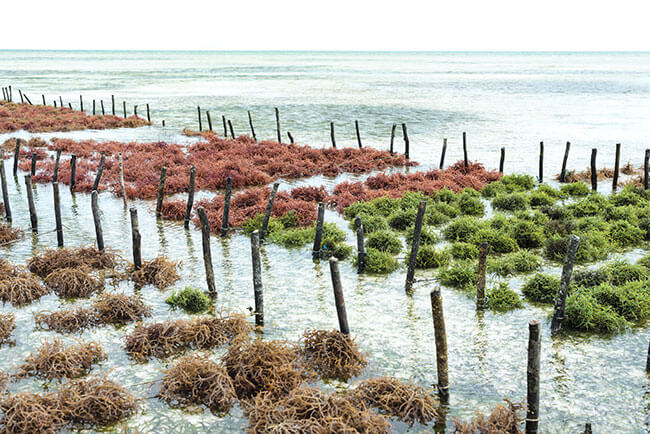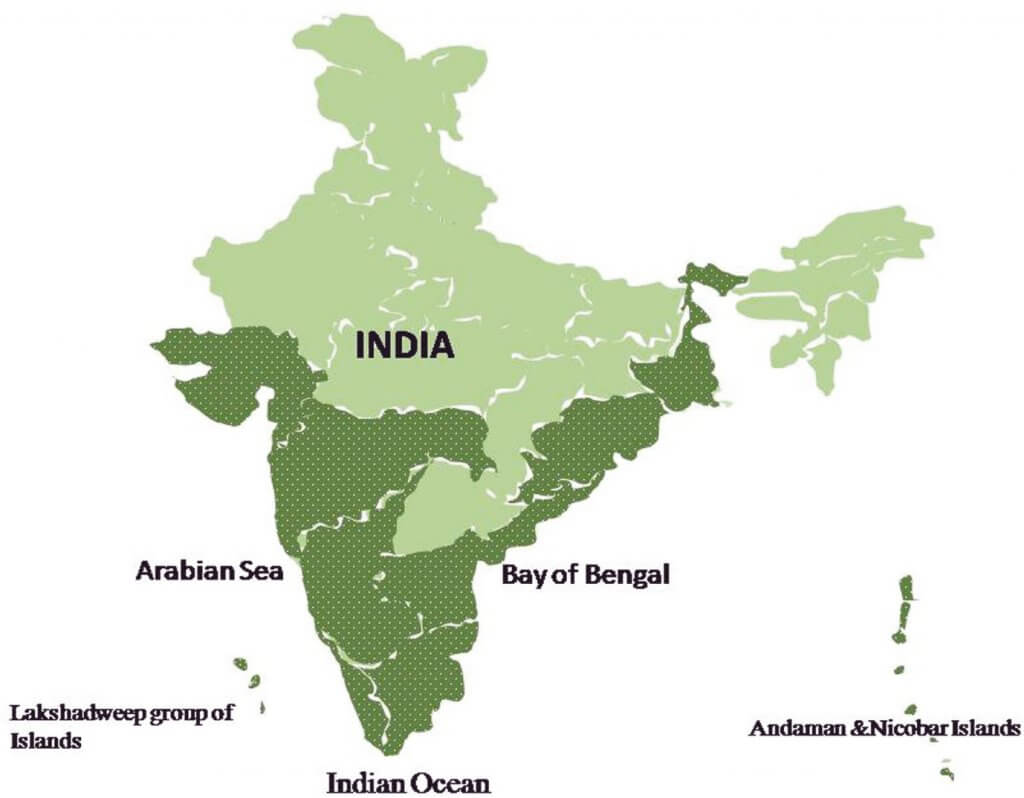Seaweed Farming
- Seaweed farming or Kelp farming is the practice of cultivating and harvesting seaweed.
- In its simplest form, it consists of the management of naturally found batches.
- In its most advanced form, it consists of fully controlling the life cycle of the algae.
Seaweeds
- Seaweed, or macroalgae, refers to thousands of species of macroscopic, multicellular, marine algae.
- Seaweed is plant-like organisms, playing a key ecological role in coastal ecosystems.
- Seaweed is the common name for countless species of marine plants & algae that grow in the ocean as well as in rivers, lakes, & other water bodies.
- A seaweed may belong to one of several groups of multi-cellular algae: the red algae, green algae, and brown algae.
- Like plants, they use light to fix atmospheric carbon dissolved in water. Macroalgae are amongst the most powerful carbon-fixing organisms on earth. Their size ranges from a few millimetres up to 50 metres.
- They are macrophytic which means they live in water or moist land surfaces.
- They generally grow in the shallow waters in the tidal zone.
- Some seaweeds are microscopic, such as the phytoplankton that lives suspended in the water column and provides the base for most marine food chains.
- Some are enormous, like the giant kelp that grow in abundant “forests” from their roots at the bottom.
- Most are medium-sized, come in colors of red, green, brown, and black, and randomly wash up on beaches and shorelines just about everywhere.
- Seaweeds exhibit the highest photosynthesis efficiency due to moist conditions.
- They contribute to about 50% of all photosynthesis in the world.

Commercial Significance of Seaweeds
- Seaweed is full of vitamins, minerals, & fibre.
- Many seaweeds contain anti-inflammatory & anti-microbial agents.
- They are known to process significant medicinal effects.
- Certain seaweeds possess powerful cancer-fighting agents.
- They are effective binding agents (emulsifiers) & are used commercial goods as toothpaste & fruit jelly, & popular softeners (emollients) in organic cosmetics & skin-care products.
Importance of Seaweed Farming
- Provide occupation for the coastal people.
- Provide continuous supply of raw material for seaweed-based industry.
- Seaweed farming is eco-friendly.
- It is a major tool to treat coastal pollution in the sea & reduce CO2 in global warming.
Seaweed Cultivation: Potential in India
- India is among the 12 mega-biodiversity nations in the world.
- India has an Exclusive Economic Zone (EEZ) of 2.17 million km2.
- The Indian coastline, with its different coastal ecosystems, supports the luxuriant growth of diverse seaweed populations, having considerable economic importance.
- About 844 seaweed species are reported from India which has a coastline of 7,500 km.
- On the West Coast, especially in Gujarat, abundant resources are present in the intertidal & subtidal regions.
- These resources have great potential for the development of seaweed-based industries in India.
- Tamil Nadu, Gujarat coasts, Lakshadweep & Andaman & Nicobar Islands are abundant in seaweed.
- Rich seaweed beds are also found around Mumbai, Ratnagiri, Goa, Karwar, Varkala, Vizhinjam & Pulicat in Tamil Nadu & Chilka in Orissa.
- Gulf of Mannar is home to more than 240 seaweed varieties out of which at least 185 are edible ones.

Challenges to seaweed harvesting in India
- Labour shortages during the paddy harvesting & transplanting season.
- Lack of livelihood security due to low wages & during bad weather.
- Lack of technology to improve processed products.
- Lack of information on new & alternative sources of raw material.
- Risky as they must be collected from depths of more than 25 to 30 feet to collect seaweed.
- Over-exploitation: While India has a rich source of seaweed varieties, we have focused only on harvesting, not cultivation thus leading to over-exploitation.
- Lack of awareness about health benefits acts as a hindrance to nutrition transition among the population.
- Less market demand.
- Lack of support from the government.
Seaweeds Mission launched for commercial farming of seaweeds
- Technology Information, Forecasting and Assessment Council (TIFAC) has launched a Seaweed Mission.
- Objective: Commercial farming of seaweeds and its processing for value addition towards boosting the national economy.
The Mission shall undertake following activities:
- Establishing model demonstration farms over one hectare for the cultivation of economically important seaweeds in nearshore and onshore along the Indian coasts.
- Establishment of seaweed nurseries for supplying seed material for large scale farming
- Onshore cultivation for
- (i) Seedling supply facility
- (ii) Seaweed cultivation for processing
- Setting up of processing plant for production of plant growth stimulants (sap) and industrially important cell wall polysaccharides such as agar, agarose, carrageenan, and alginates from fresh seaweeds
Advantages of the Mission:
- By an estimate, if cultivation is done in 5% of the EEZ area of India, it can:
- provide employment to ~ 50 million people;
- set up new seaweed industry;
- contribute to national GDP;
- increase ocean productivity;
- reduce algal blooms,
- increase Carbon sequestration;
- provide bio-ethanol of 6.6 billion litres.
Do you know?
- Out of the global seaweed production of around 32 million tons, fresh weight is valued at around 12 billion USD.
- China produces ~57 %, Indonesia ~28%, whereas India is having a mere share of ~0.01-0.02%.
Hypnea Indica and Hypnea Bullata
Two new red algal seaweed species have been discovered along India’s coastline.
- They grow in the intertidal regions of the coast, namely the area that is submerged during the high tide and exposed during low tides.
- The genus Hypnea consists of calcareous, erect, branched red seaweeds.
- There are 61 species of which 10 were reported in India. With two new species, the total number of species now would be 63.
- Location:
- Hypnea indica was discovered in Kanyakumari in Tamil Nadu, and Somnath Pathan and Sivrajpur in Gujarat.
- Hypnea bullata was discovered from Kanyakumari and Diu island of Daman and Diu.
- Significance:
- Hypnea variants of seaweeds can fetch good monetary value if commercial-scale cultivation is taken up. Hypnea contains Carrageenan, a biomolecule commonly used in the food industry.
Kappaphycus alvarezii
- Kappaphycus alvarezii, an invasive seaweed which smothers and kills coral reefs, has spread its wings to coral reef areas in Valai island in the Gulf of Mannar (GoM) and is set to invade new coral colonies in the Marine National Park.
- It has also invaded the shingle, Kurusadai and Mulli islands in Mandapam cluster.
- Kappaphycus alvarezii is a red alga but, its actual live colour is green or yellow.
- Habitat – The seaweed is native to the Indo-Pacific region.
- It has been widely introduced and cultivated in tropical regions for commercial purposes.
- IUCN Status – The invasive seaweed Kappaphycus is an IUCN red-listed species.
- Commercial significance – It is used in the production of an industrially lucrative polymer called Carrageenan.
- Carrageenan a substance extracted from red and purple seaweeds, which is used as a thickening or emulsifying agent in food products.
- Threat it poses – The rich coral reefs of Gulf of Mannar Marine National Park and the seagrass beds in Palk Bay Dugong Conservation Reserve have increasing threat from exotic seaweed Kappaphycus.
- Threat to Coral reefs – The algae was firmly attached to the coral colonies and started forming a thick gelatinous unbreakable mat over them, eventually smother and kill corals.
- Some of the islands in the Gulf of Mannar have been invaded by Kappaphycus.
- The coral reefs of Valai Island in the Keelakarai group and Krusadai Island of Mandapam group were dying due to stress from Kappaphycus invasion
- Threat to Dugongs – The commercial cultivation of Kappaphycus in Palk Bay may affect the efforts to conserve the dugong population.
- Seagrass beds, which are Dugong’s prime foraging grounds are likely to be impacted.
- Threat to other aquatic species – Also with increased Kappaphycus cover, the macro faunal and fish density is decreased.
- Turbid water
- Freshwater inflows
- Water temperature ranging from 25 °C to 30 °C
Select the correct answer code:
- a) 2 only
- b) 1, 3
- c) 3 only
- d) None of the above
A water temperature ranging from 25 °C to 30 °C is best for growing seaweed. In shallow waters near the beach, the water temperature can become quite high especially during a sunny day. Such an area is not suitable for planting seaweed.
Freshwater kills seaweed, But Seaweed prefers clear saline water and plenty of sunlight, even turbid water (muddy) will not sustain good seaweed growth.
If the water current is too strong, it can damage your plants and even wash away your planted lines by pulling down the stakes.
They are the only group of higher plants adapted to live in saltwater.
Major Seagrass meadows in India occur along the southeast coast of Tamil Nadu, in the lagoons of a few Lakshadweep Island and Andaman and the Nicobar Islands.
Solution: (c)

VERY CONCEPTUAL ANALYSIS, IT HELPS ME A LOT.
Keep Reading